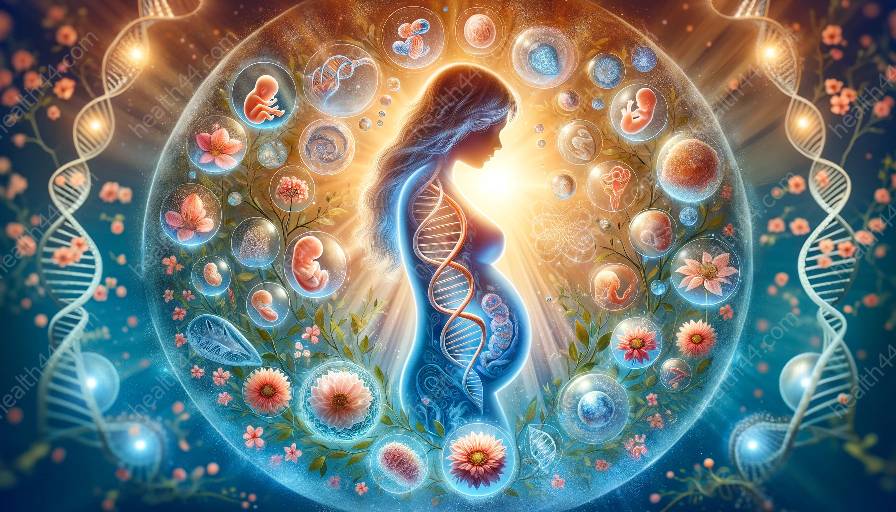Pregnancy is a time of incredible growth and development, and the exchange of nutrients and waste products between the fetus and the amniotic fluid plays a crucial role in supporting fetal well-being. Understanding how this exchange occurs provides valuable insight into the intricate processes of fetal development and the maintenance of a healthy intrauterine environment.
As the fetus grows within the uterus, the amniotic fluid, a protective liquid surrounding the fetus, serves as a dynamic medium for the exchange of essential substances. This exchange is facilitated through a complex interplay of physiological mechanisms that ensure the fetus receives necessary nutrients and disposes of waste products, allowing for proper growth and development.
Composition of Amniotic Fluid
Amniotic fluid is a complex and vital substance that is primarily composed of water, electrolytes, proteins, carbohydrates, lipids, and other essential nutrients, as well as fetal cells, hormones, and waste products. The fluid is continuously replenished and removed through the fetal swallowing and urination processes, maintaining a delicate balance that supports fetal health.
The exchange of nutrients and waste products between the fetus and the amniotic fluid occurs through several key mechanisms, each playing a significant role in ensuring a healthy prenatal environment.
1. Fetal Swallowing and Digestive Function
One of the primary mechanisms for the exchange of nutrients and waste products involves fetal swallowing and digestive function. As the fetus swallows amniotic fluid, essential nutrients and compounds are absorbed through the gastrointestinal tract. This process allows the fetus to receive vital substances such as proteins, carbohydrates, fats, and electrolytes from the amniotic fluid, supporting growth and development.
Conversely, waste products produced by the fetus, including metabolic by-products and cellular debris, are released into the amniotic fluid following digestion and metabolic processes. This exchange helps to prevent the accumulation of waste materials within the fetus, promoting optimal physiological function.
2. Fetal Urination and Excretion
In addition to swallowing, fetal urination plays a critical role in the exchange of nutrients and waste products with the amniotic fluid. As the fetus's kidneys mature, they begin to produce urine, which is released into the amniotic sac. Through this process, the fetus excretes waste products such as urea, creatinine, and other metabolic by-products, preventing the build-up of potentially harmful substances within the intrauterine environment.
Simultaneously, the amniotic fluid acts as a reservoir for essential electrolytes and water, which are absorbed through the fetal skin and respiratory system, contributing to the maintenance of fluid and electrolyte balance within the developing fetus. This dynamic exchange of fluids serves to support the proper functioning of the fetal cardiovascular and renal systems, essential for healthy growth and function.
3. Placental Transfer and Circulation
Central to the exchange of nutrients and waste products is the placenta, a vital organ that serves as the interface between the maternal and fetal circulatory systems. Through the intricate network of placental blood vessels, essential nutrients such as oxygen, glucose, amino acids, and vitamins are transferred from the maternal bloodstream to the fetal circulation, ultimately reaching the amniotic fluid to support the developing fetus.
Conversely, waste products generated by the fetus, including carbon dioxide and metabolic by-products, are transported from the fetal circulation to the placenta for elimination through the maternal bloodstream. This process ensures the removal of waste materials from the fetal system, maintaining a healthy and balanced intrauterine environment.
Impact on Fetal Development
The exchange of nutrients and waste products between the fetus and the amniotic fluid has a profound impact on fetal development. Adequate nutrient supply from the amniotic fluid is essential for supporting the growth and maturation of fetal organs, including the brain, lungs, liver, and gastrointestinal tract. Furthermore, the removal of waste products through this exchange mechanism helps to prevent the accumulation of toxic substances within the fetal environment, safeguarding the developing fetus from potential harm.
Research has shown that disruptions in the exchange of nutrients and waste products, such as in cases of intrauterine growth restriction or maternal malnutrition, can significantly impact fetal development, leading to growth delays, organ dysfunction, and long-term health consequences. Understanding the intricacies of these exchange processes is essential for identifying and addressing potential risk factors that may compromise fetal well-being.
Conclusion
The exchange of nutrients and waste products between the fetus and the amniotic fluid is a fundamental aspect of prenatal development, shaping the intrauterine environment and supporting optimal fetal growth and maturation. By comprehending the mechanisms involved in this exchange, healthcare professionals and expectant parents can gain valuable insights into the factors influencing fetal well-being and take proactive steps to promote a healthy pregnancy and birth outcome.


